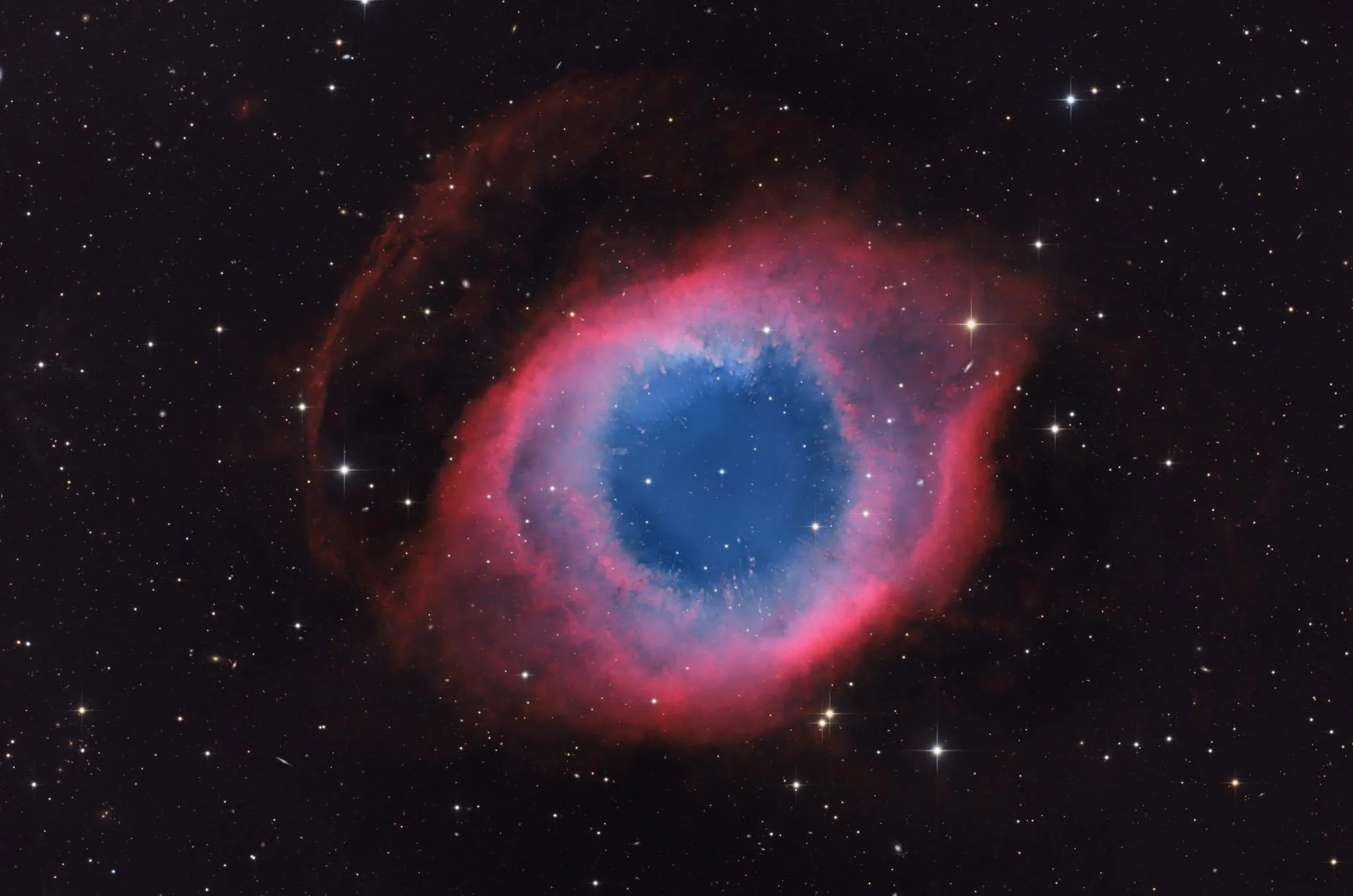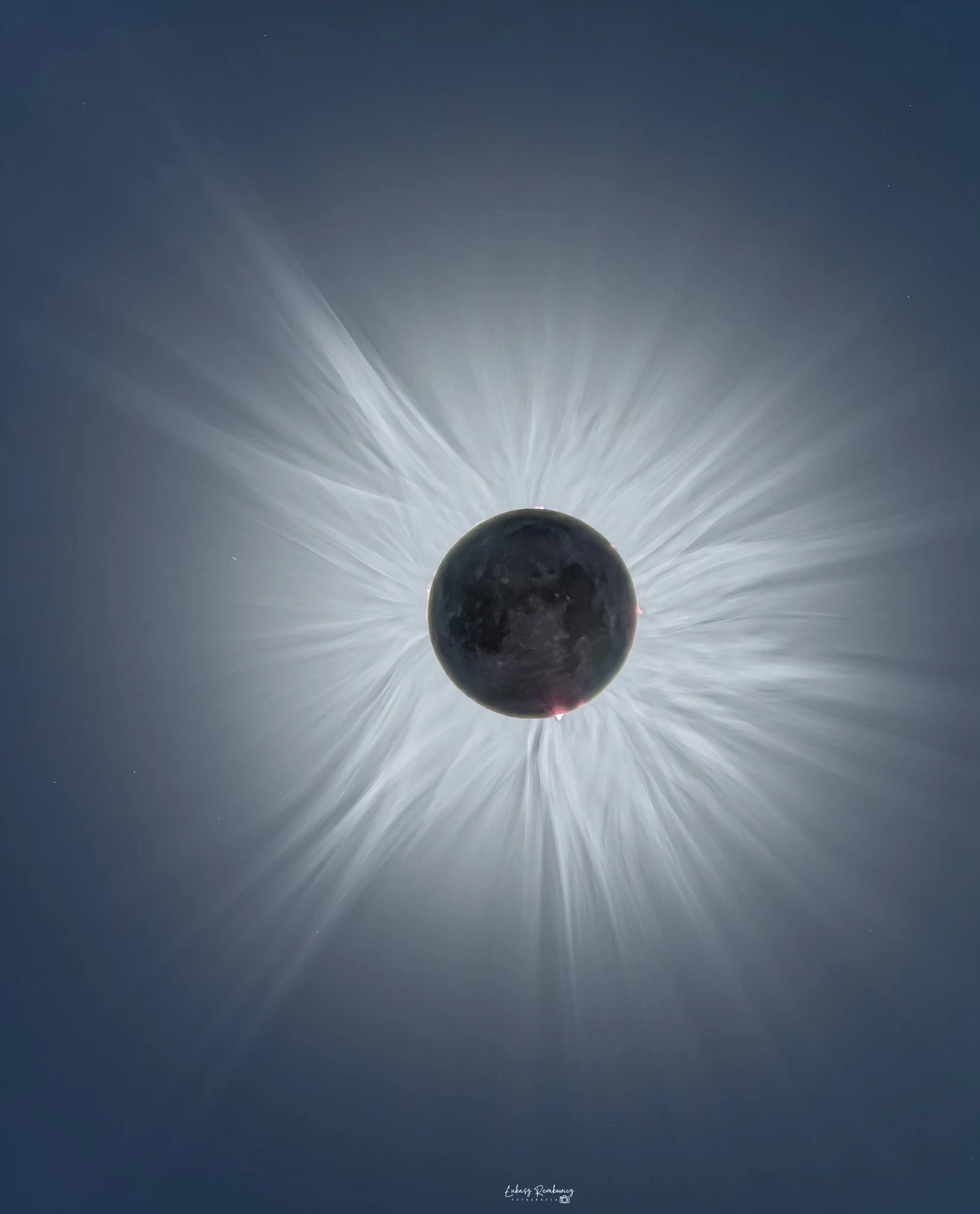
AAPOD2 Image Archives
High resolution Cat’s Eye planetary nebula
NGC 6543, commonly known as the Cat’s Eye Nebula, is one of the most structurally complex nebulae known. Located about 3,300 light-years from Earth in the constellation Draco, this planetary nebula showcases a stunning array of intricate features when observed in high resolution. Its central region, a roughly 1,000-year-old planetary nebula, displays a bright, elliptical core surrounded by concentric rings, jets, and intricate filaments of gas.
The Cat’s Eye Nebula is a prime example of the end stages of stellar evolution for medium-mass stars. The nebula’s unique structure is believed to result from the interactions between the fast winds from the central star and the slower-moving material ejected in earlier phases. High-resolution imaging, especially from the Hubble Space Telescope, has revealed the nebula’s complex geometry, helping astronomers understand the mechanisms driving the formation of such elaborate shapes in planetary nebulae.
Solar Total Eclipse (HDR)
This HDR composite image of the Solar Total Eclipse, photographed in Arkansas, USA, captures the celestial event in stunning detail. The image is a blend of nine different exposures, ranging from 1/200 to 1.3 seconds, meticulously combined to reveal the intricate details of the eclipse. Visible in the photograph are the moonshine, the Sun's corona, and several solar protuberances, showcasing the dynamic interplay between the Moon and the Sun during this rare alignment.
The blending of multiple exposures allows for a comprehensive view of the eclipse, balancing the brightness of the Sun's corona with the subtle glow of the moonshine. The Sun's corona, the outermost part of its atmosphere, appears as a halo of plasma, visible only during a total solar eclipse. The solar protuberances, or prominences, are large, bright features extending from the Sun's surface, composed of hot ionized gases. This detailed capture not only highlights the beauty of the eclipse but also provides a scientific glimpse into the complex phenomena occurring in our solar system.
M13 Hercules' Diamonds
M13, also known as the Great Globular Cluster in Hercules, is one of the most remarkable objects in the northern sky. Situated in the constellation Hercules, this globular cluster is a densely packed sphere of hundreds of thousands of stars held together by gravity. Its compact core shines brilliantly, while its outer regions extend in a vast halo of fainter stars.
Located approximately 22,200 light-years away from Earth, M13 is one of the brightest and largest globular clusters visible from the Northern Hemisphere. Its age is estimated to be around 12 to 13 billion years old, making it one of the oldest known objects in the Milky Way galaxy. Studying M13 provides astronomers with valuable insights into the formation and evolution of globular clusters, offering a window into the early history of our galaxy.
The Markarian Chain
The Markarian Chain, a striking arrangement of galaxies, stretches across the Virgo constellation, forming a captivating celestial chain. This cosmic spectacle is a visual treat for astronomers and stargazers alike, showcasing a diverse collection of galaxies bound together by gravity.
At the heart of the Markarian Chain lies the Virgo Cluster, one of the richest galaxy clusters in the nearby universe. This cluster hosts hundreds of galaxies, ranging from massive ellipticals to intricate spirals and irregulars. The Markarian Chain itself is composed of numerous interacting and merging galaxies, their gravitational dance shaping the evolution of the cosmic landscape.
ATLAS - the unexpected Supernova Remnant G209.8-8.2 in Orion
Supernova Remnant G209.8-8.2, nestled within the sprawling constellation of Orion, stands as a testament to the cataclysmic events that shape the cosmos. Born from the explosive death of a massive star, this remnant carries the echoes of a stellar demise, scattering its remnants across the cosmic landscape. As the shockwave from the supernova blast continues to propagate through space, it interacts with the surrounding interstellar medium, creating intricate patterns of gas and dust that trace the remnants of the progenitor star.
Spanning across vast expanses of space, Supernova Remnant G209.8-8.2 offers astronomers a glimpse into the turbulent aftermath of a supernova explosion. Its intricate structure, shaped by the forces of stellar winds and interstellar dynamics, provides valuable insights into the life cycle of stars and the processes that govern the evolution of galaxies. Studying this remnant allows scientists to unravel the mysteries of stellar explosions, shedding light on the origins of heavy elements and the energetic phenomena that shape the universe. As it graces the night sky with its celestial presence, Supernova Remnant G209.8-8.2 stands as a reminder of the dynamic and ever-changing nature of the cosmos.
Barnard's Merope IC349, inside Merope NGC1435 in the Pleiades
Amidst the cosmic tapestry of the Pleiades star cluster, the ethereal beauty of Barnard's Merope, designated IC 349, unfolds as a delicate nebular veil draped around the celestial jewel Merope. This intricate scene captures the interplay of interstellar dust and starlight, creating a celestial spectacle that graces the Pleiades with a touch of cosmic elegance.
IC 349, a reflection nebula, mirrors the radiant glow of Merope, one of the Seven Sisters within the Pleiades cluster. The nebular veils, illuminated by the star's brilliance, add a subtle celestial adornment, enhancing the visual richness of this stellar ensemble. As astronomers gaze upon Barnard's Merope, they witness not only the aesthetic charm of interstellar dust but also the scientific significance embedded in the delicate dance between starlight and cosmic particles. This cosmic tableau serves as a testament to the intricate relationships within star clusters, offering a glimpse into the astrophysical processes that shape and adorn our celestial surroundings.
Robin’s Egg Nebula
NGC 1360 is interesting for several reasons:
First, it is one of the few planetary nebulae where an intense stellar magnetic field has been observed. Indeed, the central star of this nebula has an intense magnetic field observed and the fast wind is no longer present, which indicates that a reflux process has probably developed.
Secondly, the nebula shows an elongated morphology and almost without relief, with no apparent glossy edge, no clear inner boundary or central cavity. The absence of a central cavity explains and confirms the absence of fast stellar winds.
Third, This nebula presents a bipolar jet of matter from its host star.









